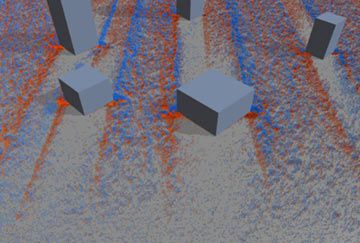Posted By Gbaf News
Posted on March 29, 2014

Only true 3D crowd simulation can offer designers real freedom to design the best-performing buildings

Big Crowd Obstacles
Building Information Modelling, or BIM, can be thought of as a virtual prototype – whether of a building, a site, an infrastructure system or a city. It allows any aspect of a design’s performance to be simulated and assessed before it is built – helping us to understand the complete design at an earlier stage. Given that any building is built for the people who will use and occupy it, the goals of BIM can only truly be realised if the way people will behave in a building is understood and can be visualised in true 3D.
When software applications are used to conduct pedestrian simulation, the data input relies on the definition of building elements such as doors, stairs and escalators. Without a standardised data model, these elements have to be recreated in the simulation software. Using the IFC data schema, the model of these elements can be imported without loss of data. Oasys Software’s MassMotion pedestrian simulation tools uses the IFC data format that underpins BIM to make simulation quicker, faster and more flexible so it can become part of the design process form the very start.
Querying data, creating new scenarios and asking “what if” become practical and economical – even for crowds of tens of thousands of people. Ideas can fly, new solutions can emerge.
So Oasys Software designers work on the principle that, no matter how sophisticated and integrated 3D modelling and simulation tools become, their raison d’être is to bring to life the interactions between designers and between each design element.

MassMotion visualisation at Union Station.jpg
This evolving process that we all know as BIM is transforming the way that cities, buildings and systems are designed to perform throughout their entire life cycle, and 3D crowd simulation is adding a whole new dimension to the way designers think. Arup designers have been leading the way as the early adopters and beneficiaries of MassMotion, the pedestrian modelling tool designed by its development team at Oasys, which is now commercially available as the first and so far only truly BIM-compatible crowd simulator with native 3D capabilities.
With flagship projects like the 10-year redevelopment of Toronto’s Union Station, New York’s Hudsons Yards and a host of airport terminals and sports stadia on its CV, Oasys Software’s MassMotion is maintaining a clear thought and technical leadership in crowd simulation. It informs and influences design, it streamlines construction keeping everyone on site safe and it communicates results in a highly visual manner that is meaningful to all stakeholders and decisions makers.
With outputs that are as close to real life observations as it is possible to get, MassMotion is high on any engineer’s wish list. In addition, new SQL database-driven storage simulation data and highly flexible analysis tools makes MassMotion faster and more flexible than ever before. All this adds up to a powerful, scalable tool that is proving to be equally suitable for smaller-scale projects, with pricing that allows for a rapid return on investment. Rarely is this speed and flexibility more important that the redevelopment of a railway interchange, where there will be no question of suspending transport services during a project or excluding the travelling public from the scene altogether.
The 10-year project at Union Station in Toronto involves three major capital projects to make train, subway, and train shed facilities fit to cater for 250,000 people per day. When the project master plan was adopted in 2004, Arup was awarded the contract to assess the pedestrian flows through Union Station during refurbishment and through to 2021. MassMotion revealed a number of opportunities and constraints for the refurbishment project, as well as informing the best locations of retail, commercial and transit-related facilities.

MM Splash Screen
Clearly, there is more to crowd modelling than transport planning: there is a growing recognition of its importance in future urban redevelopment. MassMotion is looking to that future and is able to simulate the behaviour of crowds of hundreds of thousands of people across whole districts. It is, however, equally useful for exploring the behaviour of a few thousand people in a more limited space – and this it can do in real time, drawing from data in standard cad models and scheduling agents with individual agendas such as a need to get to a rail platform, grab a bite to eat, or an inclination to choose stairs over escalators. All this behaviour is informed by academic research into the nature of how crowds move (Fruin et al) and how mathematical models can be used to replicate these movements (Helbing et al).
Risk is not scalable – but MassMotion is
Whether you are dealing with one person, 1000, or 1M, there is an overarching duty to ensure safety. Whether you have one contractor on site at or a dozen, the effects of all their activities need to be assessed. The redevelopment at Birmingham New Street station is a case in point. There, the successful, seamless overnight switch from Phase 1 to Phase 2 last year not only marked a significant half way point in a massive project but also demonstrated to rail bosses the power of crowd simulation to go beyond basic evacuation planning and add value to a project.
That it all went so smoothly was in no small part due to the crowd modelling work undertaken by the Arup team who are facilitating construction work. Their job is to ensure continuing passenger safety and plan for emergency evacuation throughout the four and a half year transformation, responding quickly to multiple contractors requirements to close, say, an escalator or a platform. To this end they have introduced Oasys’s MassMotion 3D crowd simulation software to the Network Rail project and their crowd simulation work is underpinning construction staging throughout the project.
Alan Wilson, lead fire engineer in the Arup team based at New Street throughout the whole project, has responsibility for delivering crowd management solutions that will accommodate the needs of multiple construction teams. MassMotion gives his team the essential speed and the flexibility to do this, typically delivering results within the hour, revealing potential bottlenecks and issues which hand calculations would have missed. Importantly, they can also quickly interrogate the model to explore alternative solutions.
MassMotion’s highly visual genuinely-3D output that gives clear information to the stakeholders who must approve each proposed change, in this case the Fire Brigade and Network Rail.
Alan Wilson says: “I have no doubt that MassMotion has been instrumental in keeping the construction process flowing. On the Birmingham Gateway project it has more than proved itself as a tool for managing crowd movements at any scale.”
What’s New in MassMotion 6.0 for 2014
With MassMotion 6.0 you now have industry-leading analysis tools to go with MassMotion’s state-of-the-art simulation tools. With the new high-performance database to store and retrieve simulation results, you can rapidly analyse your designs using a variety of built-in graphing, mapping, and filtering tools.
MassMotion 6.0 also introduces a new user interface that adds a range of powerful new features, such as dynamic scene search, select anywhere behaviour, time tables, and dynamic properties now make it easier to work with your data, while high-quality real time 3D graphics and direct image and video capture make it easier for you to build materials and presentations.
- New database back-end for storage of simulation results
- Powerful filter based querying system
- New spreadsheet based scheduling tools
- Multiple 3D views
- Fast 3D playback of results
- Built in graphing capability
- Tabular results
- Density (LOS) textures on geometry
- Footfall tracking (paths) textures on geometry
- CSV export
- Flexible licensing options to match user requirements


